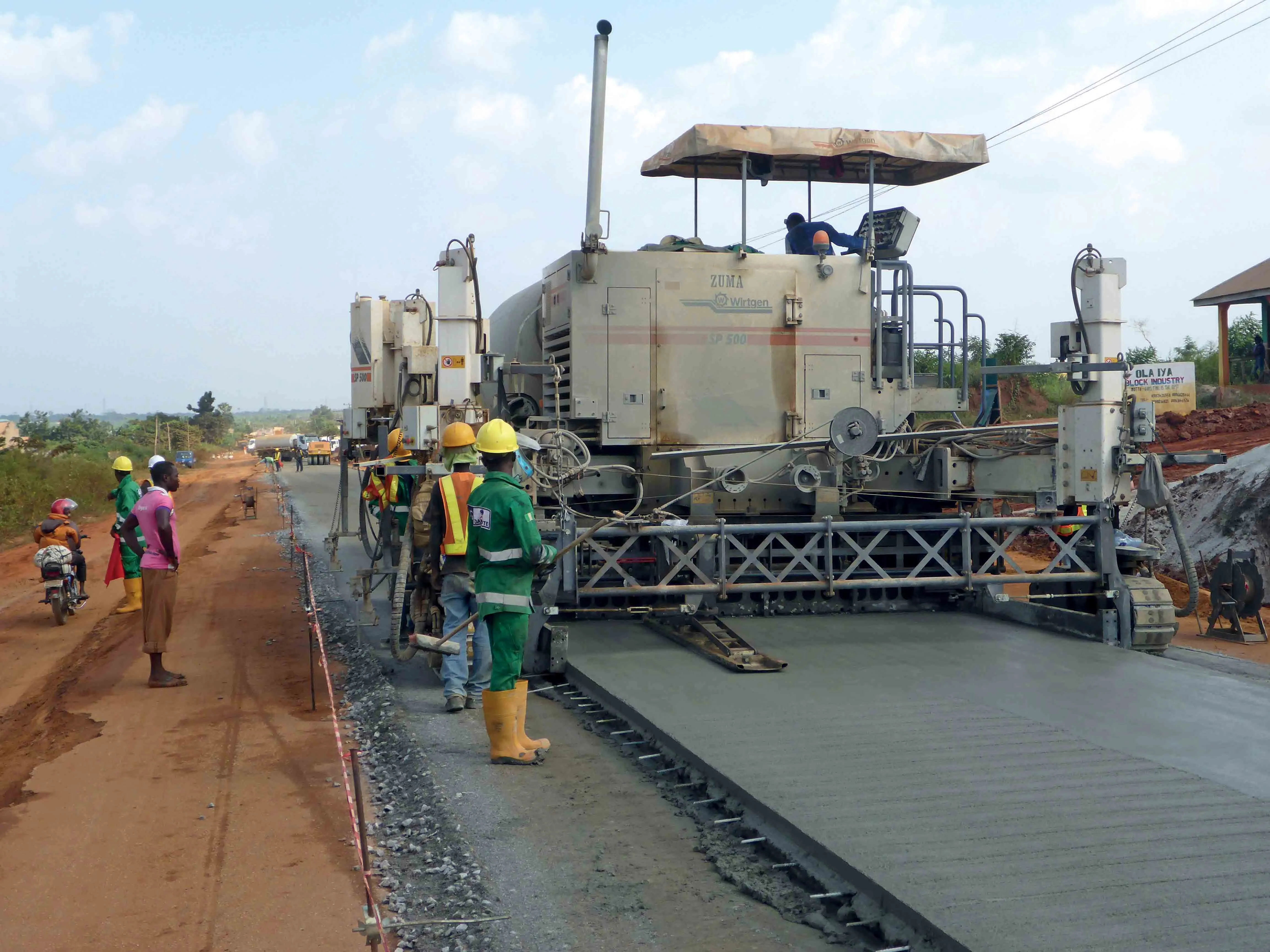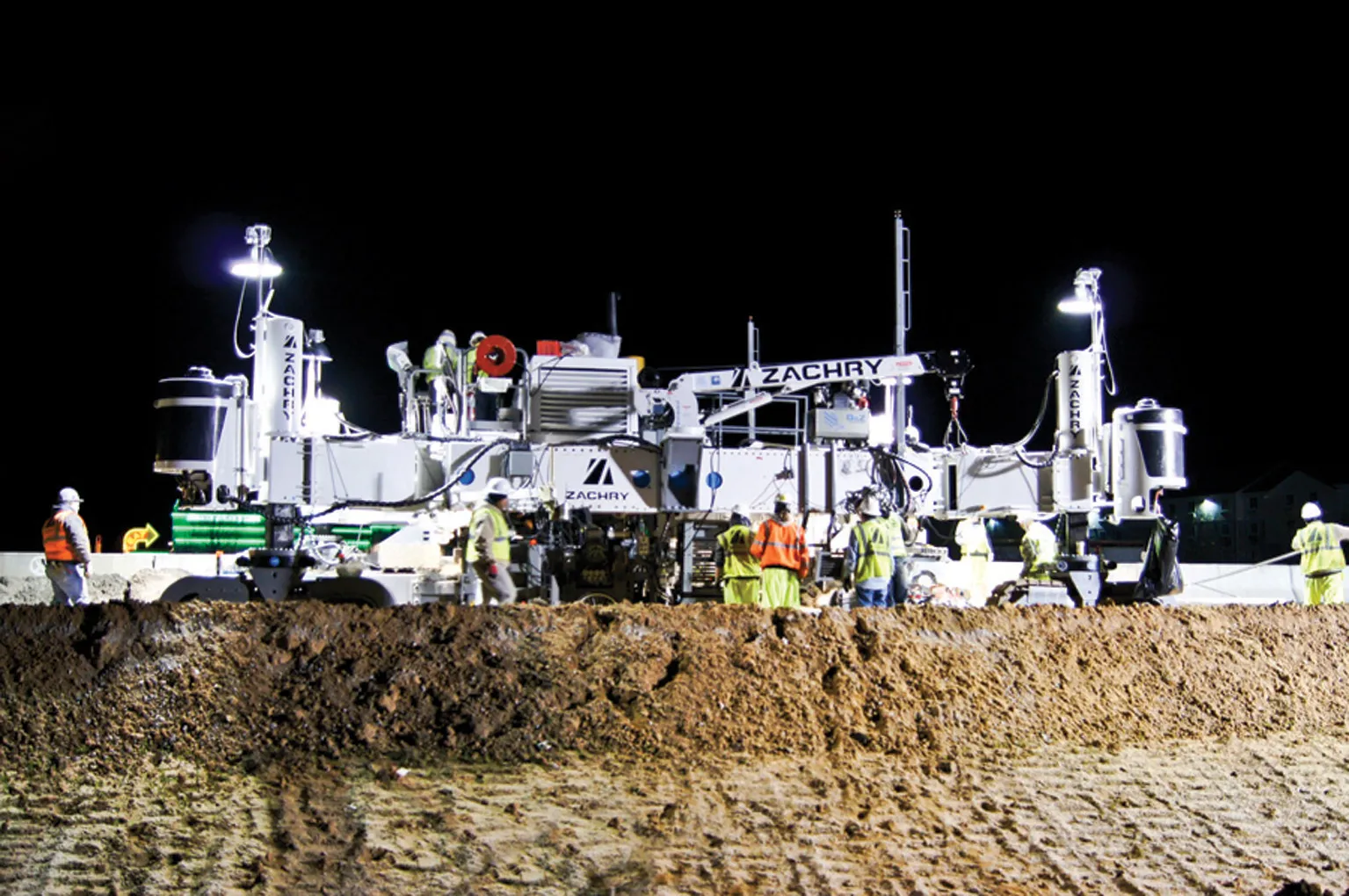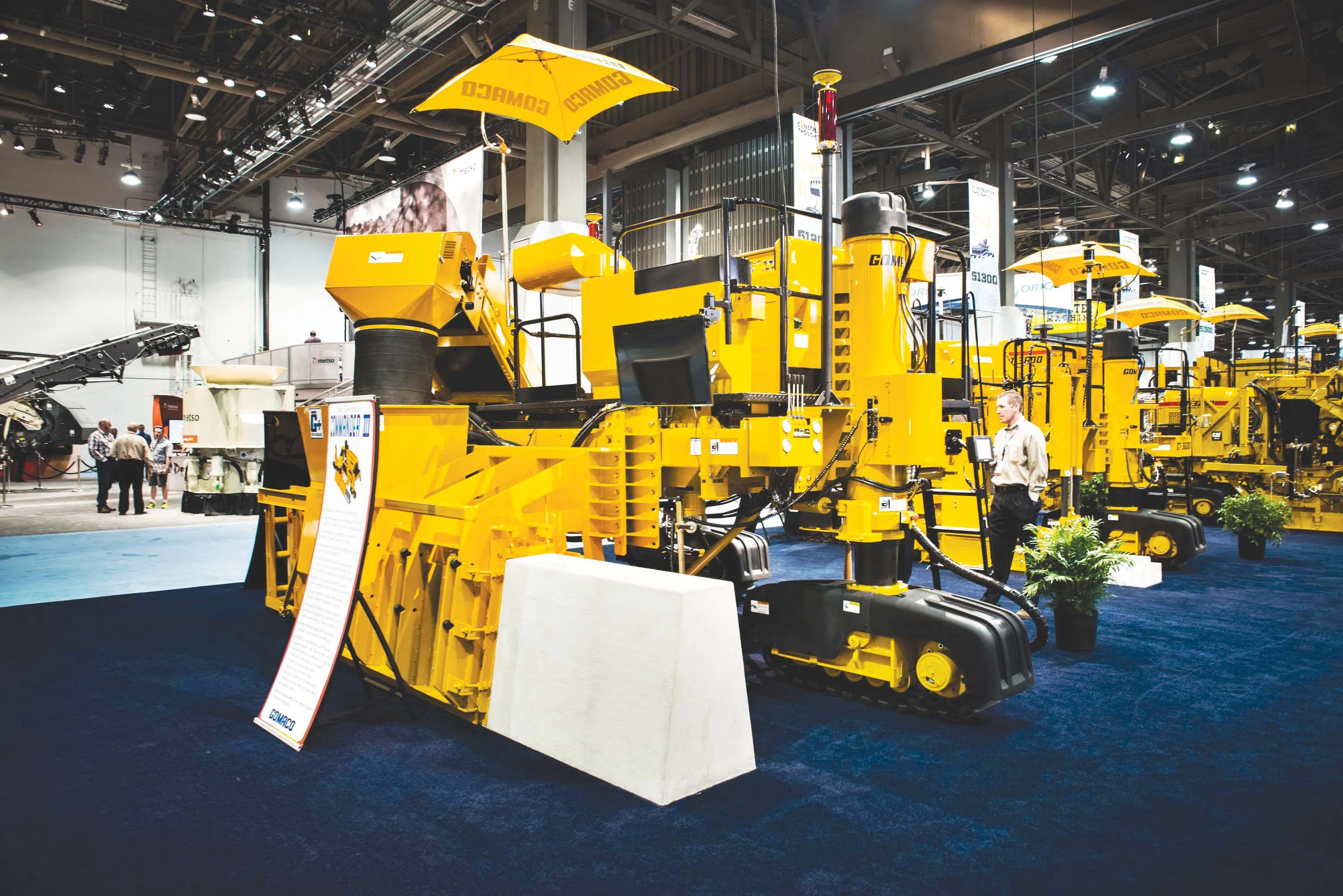A novel dual-layer concrete paving technique has been used on jobsites in Germany on the country’s high-speed Autobahn network
This technique allows the construction of a strong and durable roadway structure able to cope with heavy traffic loads and offer a long working life. In four German states, Wirtgen SP-1500 slipformers have been employed by four different contractors to carry out dual-layer paving.
The method allows a noise-reducing, non-skid exposed aggregate surface to be placed over a bottom
January 25, 2017
Read time: 5 mins

A novel dual-layer concrete paving technique has been used on jobsites in Germany on the country’s high-speed Autobahn network
This technique allows the construction of a strong and durable roadway structure able to cope with heavy traffic loads and offer a long working life. In four German states,2395 Wirtgen SP-1500 slipformers have been employed by four different contractors to carry out dual-layer paving.
The method allows a noise-reducing, non-skid exposed aggregate surface to be placed over a bottom-layer of structural concrete. The high-grade subbase offers a high load-bearing capacity and is normally 200–240mm thick. This is overlaid with a 50-80mm thick top layer of exposed aggregate concrete.
Slipform paving is used to place the two concrete grades, wet-on-wet. The compressive strength, bending tensile strength and indirect tensile strength are the same for both the bottom layer and the top but the composition of the concrete differs. While around 350kg cement/m³ is used in the bottom-layer, 420kg cement/m³ is required in the exposed aggregate concrete.
Coarse aggregate is important in the top layer and only double broken and double screened chippings with high angularity, grain shape and resistance to polishing are used. This ensures that the concrete surfacing retains its noise-reducing and skid-resistance properties as well as its long term durability.
When the two layers of concrete have been paved, a surface retarding agent is applied to the freshly smoothed surface by a texture curing machine (TCM). Depending on the weather, the coarse aggregate is exposed by brooming the surface after placing the concrete, providing the required non-skid surface with that has profile peaks and a texture lowering tyre noise.
Four German projects have used this technique, with three to rebuild 30-40 year old concrete roads and a fourth to reconstruct a stretch suffering from alkali-silica reaction (ASR).
One project was for a 4.5km rehabilitation of the A1 near Trier by8553 Berger Bau, another was for a 2.3km improvement of the A5 near Karlsruhe by Bickhardt Bau and a third for a 5.3km rebuild of the A1 near Lübeck by 3281 Eurovia Beton. The fourth was for a 4.8km improvement of a section of the A9 with ASR near Weissenfels by 8554 Max Bögl
On the A1, Berger Bau used the SP 1500 to pave a 200mm-thick bottom-layer concrete pavement with 360kg cement/m³ concrete and a maximum aggregate size of 22. Meanwhile, the 60mm-thick top-layer concrete comprised a high-grade material mix with 420kg cement/m³ concrete and double broken and double screened chippings.
But material logistics presents a challenge as two different concrete grades are required at the same time. The bottom-layer concrete is dumped directly in front of the paver, while the top-layer concrete is delivered to the second machine by a conveyor. The concrete is either filled directly from the truck into a material hopper or intermediate container, while conveyors with chutes at the end dump the top-layer onto the compacted bottom-layer.
For its job on the A9, Max Bögl used 45 articulated trucks carrying from 6,500-7,000tonnes of sand, gravel and chippings/day during the paving phase, in addition to 27 trainloads of cement. Rebuilding the highway meant managing a complex system of machines, material, weather, ambient conditions and personnel.
For this method, the bottom-layer paver is equipped with dowel bar and tie bar inserters, while the top-layer paver uses a finishing beam and super smoother to produce a level surface. The pavers feature an intelligent control system to optimise quality, with a TCM providing the finish.
Dowel bars and tie bars are inserted in the pre-compacted wet concrete at freely determined intervals by the automatic integrated dowel bar and tie bar inserter. Because the dowel bar inserter can move in the direction of paving, it can remain in position over the transverse joint until the vibratory insertion process is complete, while the slipform paver continues to advance.
In these projects, the dowel bars were positioned in the middle of the finished concrete surfacing, at intervals of 140-150mm, as specified. A closed, even and homogeneous surface was assured by a finishing beam and super smoother integrated in the top-layer paver.
So that roadways can be paved with accuracy, three of the four contractors use sensors to adjust the height of the front metering screed. These continuously measure the filling level of the concrete in the compaction zone and adjust the height of the front metering screed, ensuring that the correct quantity of material is delivered.
Curing is important when paving exposed aggregate concrete. For these jobs, a combination of surface retarding agent and dispersion is applied to the finished and smoothed surface in precise quantities. The retarding agent delays the setting and initial hardening of the concrete surface for a limited time, while the dispersion prevents the surface from drying out and cracking. As soon as the concrete has cured sufficiently to be driven over, the surface is brushed to expose the coarse aggregate and an additional dispersion is applied to the brushed surface. Exposing the coarse aggregate gives the concrete pavement its important non-skid properties.
This technique allows the construction of a strong and durable roadway structure able to cope with heavy traffic loads and offer a long working life. In four German states,
The method allows a noise-reducing, non-skid exposed aggregate surface to be placed over a bottom-layer of structural concrete. The high-grade subbase offers a high load-bearing capacity and is normally 200–240mm thick. This is overlaid with a 50-80mm thick top layer of exposed aggregate concrete.
Slipform paving is used to place the two concrete grades, wet-on-wet. The compressive strength, bending tensile strength and indirect tensile strength are the same for both the bottom layer and the top but the composition of the concrete differs. While around 350kg cement/m³ is used in the bottom-layer, 420kg cement/m³ is required in the exposed aggregate concrete.
Coarse aggregate is important in the top layer and only double broken and double screened chippings with high angularity, grain shape and resistance to polishing are used. This ensures that the concrete surfacing retains its noise-reducing and skid-resistance properties as well as its long term durability.
When the two layers of concrete have been paved, a surface retarding agent is applied to the freshly smoothed surface by a texture curing machine (TCM). Depending on the weather, the coarse aggregate is exposed by brooming the surface after placing the concrete, providing the required non-skid surface with that has profile peaks and a texture lowering tyre noise.
Four German projects have used this technique, with three to rebuild 30-40 year old concrete roads and a fourth to reconstruct a stretch suffering from alkali-silica reaction (ASR).
One project was for a 4.5km rehabilitation of the A1 near Trier by
On the A1, Berger Bau used the SP 1500 to pave a 200mm-thick bottom-layer concrete pavement with 360kg cement/m³ concrete and a maximum aggregate size of 22. Meanwhile, the 60mm-thick top-layer concrete comprised a high-grade material mix with 420kg cement/m³ concrete and double broken and double screened chippings.
But material logistics presents a challenge as two different concrete grades are required at the same time. The bottom-layer concrete is dumped directly in front of the paver, while the top-layer concrete is delivered to the second machine by a conveyor. The concrete is either filled directly from the truck into a material hopper or intermediate container, while conveyors with chutes at the end dump the top-layer onto the compacted bottom-layer.
For its job on the A9, Max Bögl used 45 articulated trucks carrying from 6,500-7,000tonnes of sand, gravel and chippings/day during the paving phase, in addition to 27 trainloads of cement. Rebuilding the highway meant managing a complex system of machines, material, weather, ambient conditions and personnel.
For this method, the bottom-layer paver is equipped with dowel bar and tie bar inserters, while the top-layer paver uses a finishing beam and super smoother to produce a level surface. The pavers feature an intelligent control system to optimise quality, with a TCM providing the finish.
Dowel bars and tie bars are inserted in the pre-compacted wet concrete at freely determined intervals by the automatic integrated dowel bar and tie bar inserter. Because the dowel bar inserter can move in the direction of paving, it can remain in position over the transverse joint until the vibratory insertion process is complete, while the slipform paver continues to advance.
In these projects, the dowel bars were positioned in the middle of the finished concrete surfacing, at intervals of 140-150mm, as specified. A closed, even and homogeneous surface was assured by a finishing beam and super smoother integrated in the top-layer paver.
So that roadways can be paved with accuracy, three of the four contractors use sensors to adjust the height of the front metering screed. These continuously measure the filling level of the concrete in the compaction zone and adjust the height of the front metering screed, ensuring that the correct quantity of material is delivered.
Curing is important when paving exposed aggregate concrete. For these jobs, a combination of surface retarding agent and dispersion is applied to the finished and smoothed surface in precise quantities. The retarding agent delays the setting and initial hardening of the concrete surface for a limited time, while the dispersion prevents the surface from drying out and cracking. As soon as the concrete has cured sufficiently to be driven over, the surface is brushed to expose the coarse aggregate and an additional dispersion is applied to the brushed surface. Exposing the coarse aggregate gives the concrete pavement its important non-skid properties.









